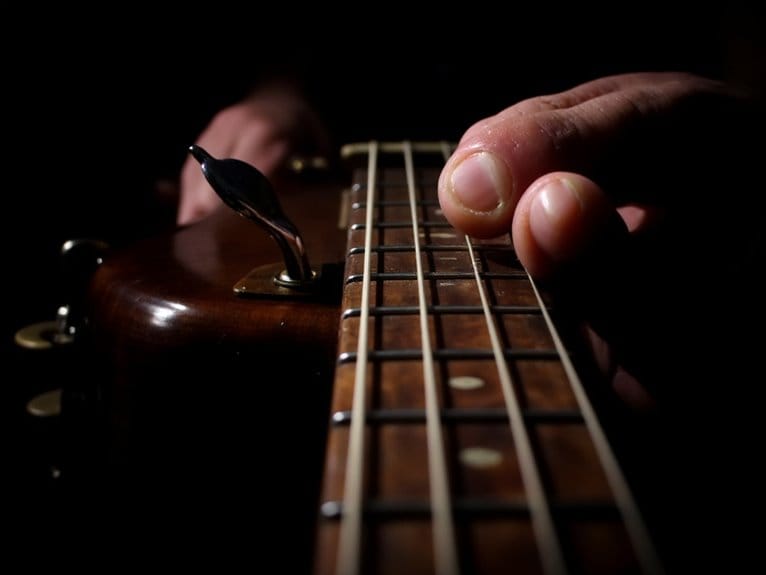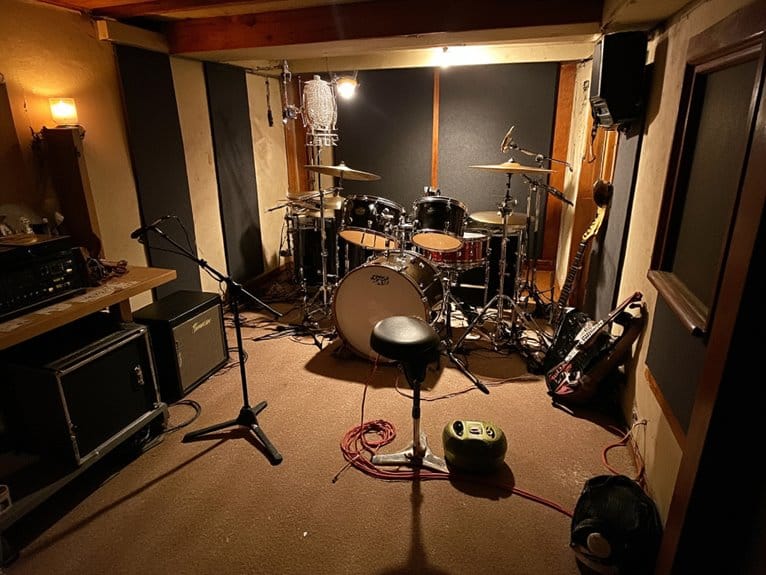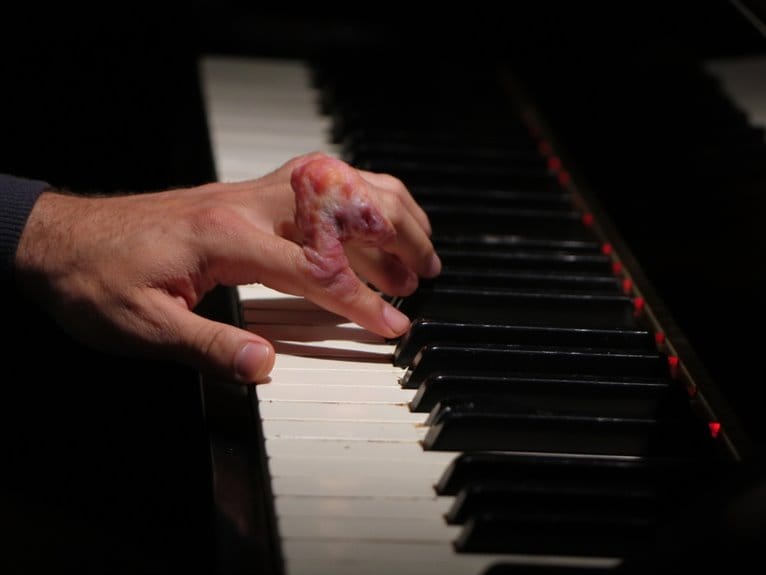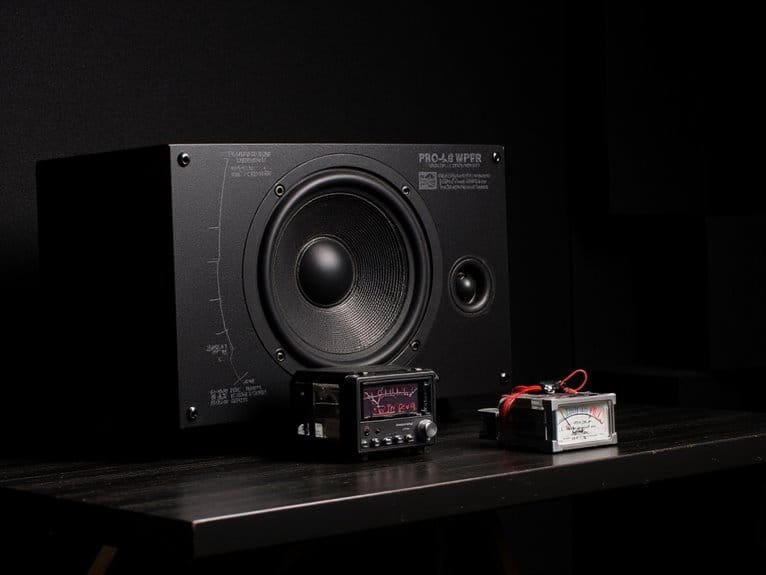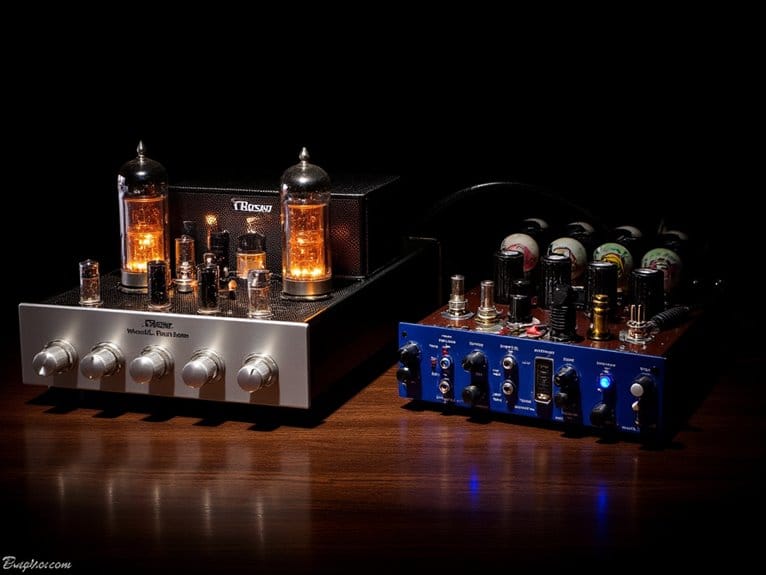Bass Harmonics: Natural and Artificial Applications
Bass harmonics transform your instrument into a bell-like melodic voice through two distinct techniques. Natural harmonics divide strings into mathematical segments by touching nodes at the 12th, 7th, and 5th frets, creating isolated overtones. Artificial harmonics combine fretted notes with harmonic touches, while tapped harmonics involve tapping twelve frets higher than your fretted position. These techniques enhance everything from funk grooves to ambient soundscapes, and mastering the precise coordination between your hands reveals even more expressive possibilities.
We are supported by our audience. When you purchase through links on our site, we may earn an affiliate commission, at no extra cost for you. Learn more.
Notable Insights
- Natural harmonics create bell-like tones by touching string nodes at specific frets, dividing strings into mathematical segments.
- Artificial harmonics combine fretted notes with harmonic touches, while tapped harmonics involve tapping twelve frets higher.
- Harmonic functions provide stability through tonic, create tension via dominant, and enable transitions through subdominant progressions.
- Different genres utilize harmonics uniquely: funk and rock for groove dynamics, jazz for melodic complexity, ambient for atmospheric textures.
- Mastery requires precise hand coordination, quality monitoring equipment, and understanding fretboard harmonic node locations for efficient playing.
Understanding Natural Harmonics on Bass Guitar
Natural harmonics represent one of those fascinating acoustic phenomena that’ll transform your understanding of how bass strings actually vibrate, creating ethereal, bell-like tones that seem to float above your instrument’s normal voice.
When you lightly touch specific points along your strings-what we call harmonic nodes-you’re fundamentally dividing the vibrating length into precise mathematical segments, allowing only certain frequencies to ring through. This process of overtone isolation produces those shimmering, bell-like tones that sustain beautifully and cut through dense musical arrangements with remarkable clarity.
The most accessible harmonics occur at your 12th, 7th, and 5th frets, corresponding to string divisions of half, third, and quarter lengths respectively, making them reliable landmarks regardless of your bass’s tuning or string gauge preferences. For bassists looking to practice these techniques, 40mm drivers in quality headphones can effectively reproduce both the fundamental bass frequencies and the delicate harmonic overtones. Exploring harmonics on the small bass guitar can offer a unique and vibrant sound, making it easier for players to experiment with different genres. Additionally, these guitars often provide the advantage of a more comfortable playing experience, allowing for extended practice sessions without discomfort. By combining the accessibility of harmonics with the versatility of short scale instruments, bassists can expand their musical repertoire significantly. Investing time in harmonics can also enhance a bassist’s overall musicianship, as it encourages deeper listening and a greater understanding of sound production. Moreover, the process of experimenting with harmonics can inform your bass gear selection, guiding choices in pickups, amplifiers, and effects pedals to complement your unique style.
To fully appreciate these subtle harmonic frequencies during practice, quality headphones with extended frequency response ranges and larger drivers are essential for capturing the deep fundamental tones alongside the delicate harmonic overtones.
Mastering Artificial and Tapped Harmonic Techniques
While natural harmonics rely on open string vibrations, artificial harmonics reveal a completely different dimension of bass expression by combining fretted notes with precisely placed harmonic touches. This fundamentally allows you to access harmonic overtones from any chromatic position on your fretboard.
This harmony manipulation requires performance precision, demanding strict coordination between your fretting and picking hands to produce clean, bell-like tones.
Tapped harmonics involve fretting a note, then tapping exactly twelve frets higher with your picking hand finger, while pinch harmonics combine plucking with simultaneous light string contact.
Mastering artificial harmonics demands precise coordination between fretting and tapping techniques to unlock the bass guitar’s hidden overtone palette.
The Steve Bailey technique showcases advanced finger coordination, enabling smooth harmonic production through intricate picking hand movements. Different harmonic nodes produce varying overtone colors, and controlling pick attack angle influences brightness and sustain, offering dynamic tonal possibilities.
Harmonic Function and Bass Role in Musical Context
Beyond the technical mastery of producing harmonics lies the fundamental understanding of how your bass functions within the broader harmonic landscape of music, where every note you play either supports, challenges, or redirects the underlying chord progressions that give songs their emotional weight and forward momentum. Recognizing the effects of bass techniques can elevate your playing, allowing you to create more intricate layers and textures within the music. By experimenting with rhythm, dynamics, and articulation, you can enhance your contribution to the harmonic interplay, ultimately leading to a richer sonic experience. This deeper connection to the harmonic structure will not only enhance your individual performance but also strengthen your collaboration with other musicians.
Your bass harmonics work within three essential functions that shape musical narrative:
- Tonic function – creates bass stability and resolution, anchoring the harmonic home base
- Dominant function – generates harmonic tension that demands release back to tonic
- Subdominant function – provides preparatory exchange between stability and tension
When you’re playing harmonics, you’re not just creating ethereal tones; you’re participating in centuries-old patterns of tonal resolution that listeners instinctively recognize, making your harmonic choices vital for supporting or subverting musical expectations.
Creative Applications Across Musical Genres and Styles
When you start exploring how bass harmonics function across different musical genres, you’ll quickly discover that what began as a classical technique has evolved into one of the most versatile tools for creative expression in modern music.
In funk and rock, you’ll find that artificial harmonics deliver percussive sparkle that enhances groove dynamics, while jazz bassists employ these techniques for melodic enrichment and expressive complexity. Additionally, the use of a bass compressor pedal can further accentuate these harmonics, allowing for a tighter, more defined sound that complements the genre’s rhythmic foundations. This device helps maintain a consistent volume level, making subtle nuances in harmonic playing more pronounced.
Ambient musicians exploit harmonic textures to create atmospheric layers and soundscape depth, and reggae players use them for melodic ornamentation.
You can extend your melodic range beyond typical fretted notes, create bell-like tones that complement lead instruments, and develop rapid arpeggios that add dramatic effects to your playing across virtually any musical style.
On a final note
You’ve now explored how natural harmonics create those bell-like tones at specific fret positions, while artificial harmonics reveal endless melodic possibilities through precise finger placement and pick control. I’ve found that mastering these techniques transforms your bass playing from purely rhythmic foundation to melodic expression, whether you’re adding subtle texture in jazz contexts or creating dramatic effects in progressive rock. Practice consistently, and you’ll discover harmonics become second nature in your musical vocabulary.

